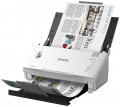Colour depth (int.)
Under the internal colour depth is meant the number of shades of the image that the scanner itself can recognize; it should not be confused with external depth, which is the amount of hue transmitted to the computer (see below). Colour depth is expressed as the number of bits of information used to encode data about each colour. The total number of colour shades in this case is 2 to the power of n, where n is the colour depth. So, a 24-bit scanner recognizes 16.7 million colours — which is more than one and a half times more than the human eye, and quite enough for simple everyday tasks. In more advanced professional models, colour depth can reach 96 bits. Although the characteristics of the image transmitted to the computer are described by the external colour depth (which can be less than the internal colour depth), the internal depth, however, also affects its quality: other things being equal, a scanner with a higher internal depth provides more accurate colour reproduction.
Colour depth (ext.)
External colour depth characterizes the maximum possible number of colour shades in the image transmitted by the scanner to the computer. A depth of 24 bits is considered quite enough for non-professional tasks, in more advanced models this parameter can reach 96 bits. For details on colour depths and their relationship, see "Colour Depth (Int.)"
Mono scanning
The black and white scanning speed provided by the device. Usually, the maximum processing speed for an A4 sheet is indicated, i.e. speed at the lowest resolution. In fact, the speed is usually lower and depends on both the resolution and the size of the original material. The higher the scanning speed, the more convenient it is to work with the scanner; pay special attention to this parameter if you plan to work with numerous black and white images.
Colour scanning
Colour scanning speed provided by the device. In fact, it depends on the selected resolution, colour depth and original dimensions; the characteristics most often indicate the speed for an A4 sheet at the minimum resolution and colour depth, i.e. maximum possible speed. If you only need to scan one or more sheets from time to time, high speed is not too critical, but for working with a large amount of materials, you should look for fast models.
Operating cycle
The maximum number of pages that the scanner can process per day without overloading and the negative consequences associated with them. Most often indicated for A4 format. Even the most modest models of modern scanners have duty cycles measured in dozens of pages, which is quite enough for simple everyday tasks. Therefore, you should pay attention to this parameter if you have to scan numerous materials every day.
Power source
— From the network. The most common option is to connect to a conventional 230 V power supply. This power supply provides enough power to operate any, even the fastest and most performant scanners. Its disadvantage is, in fact, the need for an electrical network.
— From USB.
Powered via USB port — the same through which it connects to the computer. This significantly increases the battery life of the scanner — in particular, it can be used with a laptop in places where there is no access to a 230 V network, which is especially important for portable models (see "Portable Design"). On the other hand, the performance of such devices is usually low, and the power of the USB port is not always enough for power supply (which is especially true when using USB hubs).
— Autonomous. Power supply of the scanner from its own batteries (accumulator or replaceable batteries). Such models are as autonomous as possible, because do not require a power cord to operate, and many of them are able to act as separate devices without being connected to a PC at all. Their disadvantage is the risk of switching off at the most inopportune moment due to the exhaustion of the charge — then you have to either change the batteries (which at least requires fresh ones) or recharge the battery (which takes time).
Power consumption
The maximum power consumed by the scanner during operation. The higher the power, the more energy the scanner consumes, but this only applies to the scanning process itself — in standby mode, power consumption is negligible. And even at the peak in most models, the power is so low that in fact this parameter has practically no effect on electricity bills and is more of an auxiliary value (for example, it is used to calculate the total power of devices connected to an uninterruptible power supply).

